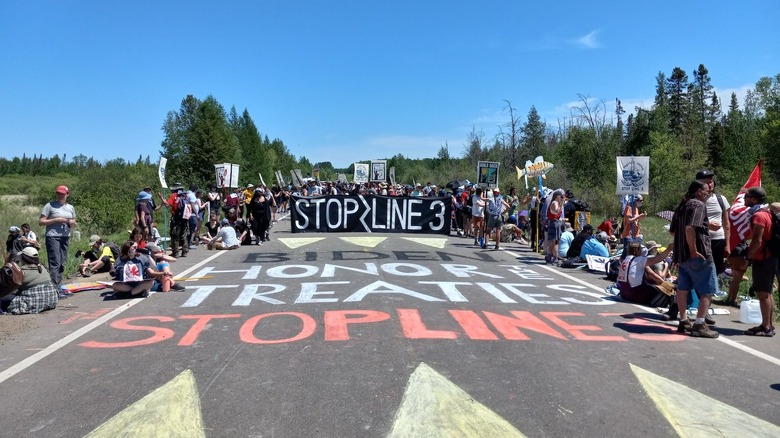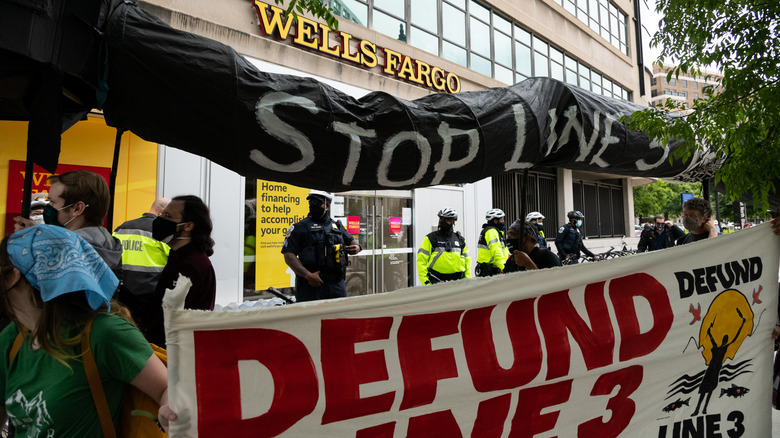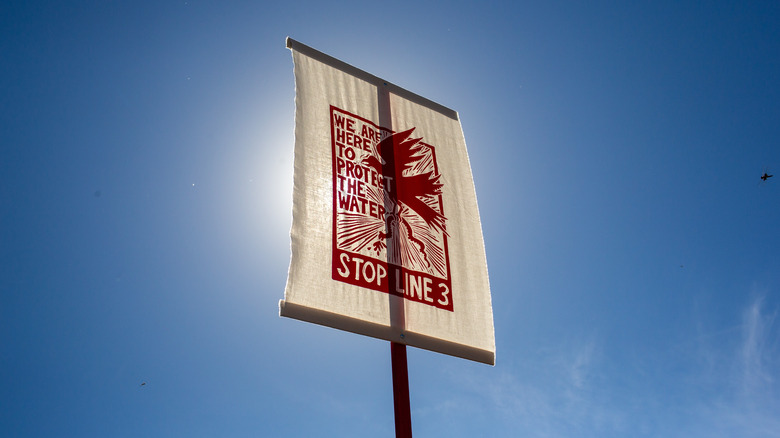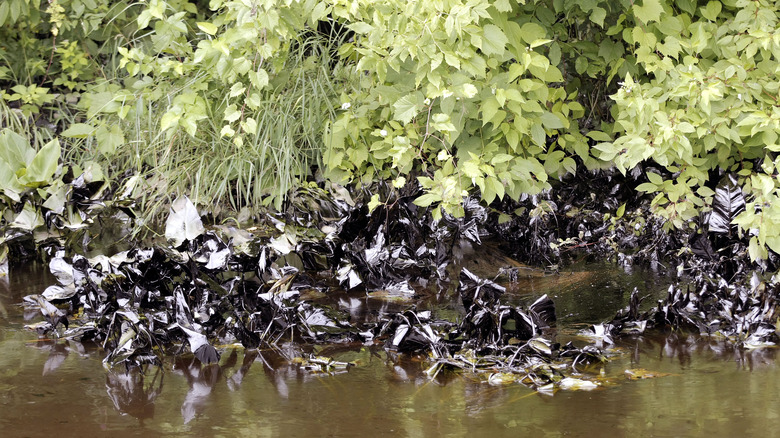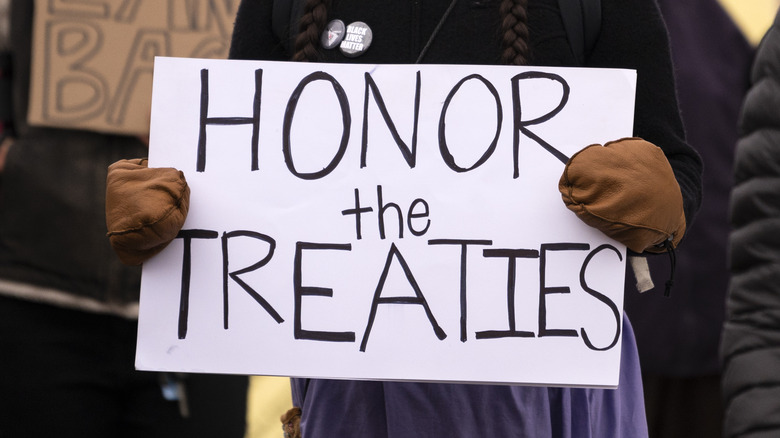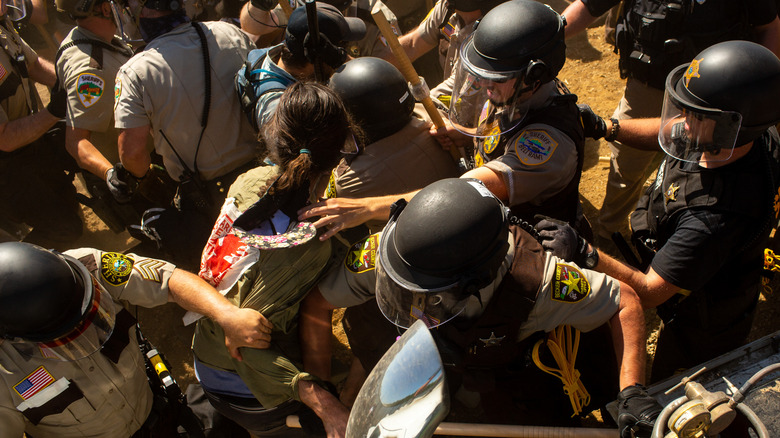What's Really Going On With The Line 3 Pipeline?
Although President Joe Biden effectively canceled the Keystone XL pipeline project by revoking a necessary permit, he and his administration have been silent on the Line 3 pipeline being constructed by Enbridge. Line 3 has also faced a series of legal challenges, and there are movements that hope to pressure banks into defunding the project, per Atmos. But if Biden determined that the Keystone XL pipeline was going to be detrimental to the environment, what makes Line 3 any different? As Simone Senogles of the Indigenous Environmental Network said, "If we stop one pipeline, that doesn't mean other pipelines can't harm the environment."
Neither the pipeline nor the jobs Enbridge claims it would create have long-term viability. Grist notes that while Enbridge claimed that 75% of Line 3 workers would be from nearby communities in Minnesota, "in actuality, only about 33% of the workforce lives in Minnesota." And once construction is finished, those jobs will disappear as well.
Led primarily by Indigenous women and two-spirit people, Indigenous nations and environmental groups continue to resist the pipeline's construction — both on the ground and in the courtroom. As Big Wind notes in an interview with Atmos, "this is a multi-pronged strategy." Here's what's really going on with the Line 3 pipeline.
What is Line 3?
Line 3 is a crude oil pipeline that is being built by Canada-based pipeline company Enbridge, which plans to transport crude oil from Hardisty, Alberta to Superior, Wisconsin. Although Enbridge describes it as a replacement for the existing Line 3 pipeline, the "replacement" still involves building a new pipeline route in Minnesota, per PBS. Honor the Earth also notes that the existing Line 3 pipeline isn't going to be removed. Instead, the new project will be built alongside most of the preexisting route, but this time the pipe will be larger — 36 inches instead of 34 inches — carrying almost twice the volume of oil. The non-profit noted that this would make Line 3 "one of the largest crude oil pipelines in the continent."
By November 2020, Line 3 construction was completed in Canada, North Dakota, and Wisconsin. Line 3 got its final permit approval in November 2020, and in December 2020, Enbridge started construction on the Minnesota portion of the pipeline. However, Line 3 also crosses Indigenous treaty lands, and tribal governments and indigenous activists have been protesting the construction of the channel since Enbridge proposed it. Associated Press writes that as of July 15, 2021, Anishinaabe communities that are protesting the pipeline — including the Red Lake Nation, White Earth Band of Ojibwe, and Mille Lacs Band of Ojibwe — have petitioned the Minnesota Supreme Court to hear their case.
The history of Line 3
The existing Line 3 was originally built by Enbridge in 1961 and began operating in the late 1960s. According to Stop Line 3, the pipeline goes through northern Minnesota, the Leech Lake, and Fond du Lac reservations, as well as the l855, 1854, and l842 treaty areas. And because the original Line 3 pipeline was built with defective steel, it now suffers from over 900 structural integrity problems and "anomalies," per Honor the Earth.
Because of these issues of corrosion, Line 3 has been operating at a reduced capacity since 2008, per Enbridge. And Line 3 has already suffered from numerous leaks ever since its creation and is even responsible for "the largest inland oil spill in U.S. history," MPR News reports. Specifically, on March 3rd, 1991, a rupture in the Line 3 oil pipeline in Grand Rapids, Minnesota resulted in 1.7 million gallons of crude oil being spilled onto the Prairie River. Thankfully, because the river was frozen, clean-up crews were able to keep the oil from the Mississippi River and from contaminating the drinking water.
Enbridge's history of spills
The Enbridge pipeline company has a significant history of oil spills, which can have drastically damaging effects on marine animals such as sea turtles. They were also responsible for the Kalamazoo River Oil Spill in Michigan, which, according to Vox, was "the second-biggest inland oil spill in U.S. history."
Enbridge reportedly didn't notice the spill for 17 hours, despite the fact that more than 1 million barrels of crude oil were spilling out of Line 6B into Talmadge Creek and spreading to the Kalamazoo River. And just ten days before the rupture occurred, Richard Adams, the Enbridge vice president of U.S. operations for liquid pipelines, claimed in testimony before Congress that Enbridge's response to spills was "almost instantaneous." The Natural Resources Defense Council writes that the subsequent clean-up took over five years.
Oil and Water Don't Mix writes that Line 5 has had 15 documented failures, which led to over 260,000 gallons of oil spilling. And one of the most significant spills out of Line 5 alone happened in 1999 when almost a quarter of a million gallons of oil and natural gas spilled into a march by Crystal Falls, Michigan.
The biggest issues of Line 3
The issue of Line 3 is two-fold, concerning the original pipeline as well as the new one. Because there are "no abandonment guidelines or definitions for intrastate crude oil pipelines," per Honor the Earth, Enbridge could potentially abandon the old pipeline and avoid all responsibility for assessing and repairing all the contamination it has already caused.
Meanwhile, the new pipeline not only continues to put the Great Lakes and its surrounding ecosystems at risk, but it also crosses Ojibwe treaty lands and "violate[s] the treaty rights of the Anishinaabeg," writes Stop the Line. And in order to build Line 3, Enbridge was granted powers of eminent domain, allowing it to seize property without the consent of the landowner as the government can. All of this despite the fact that it's a private company and will earn "billions in profit," per Honor the Earth.
Atmos also writes that oil extraction projects have been shown to lead to an increase in crime, especially sexual violence against Indigenous women. And in June 2021, The Guardian reported that one crisis center for survivors of violence had received over 40 reports from people who experienced harassment or assault from Line 3 workers.
In its environmental impact statement, Minnesota's Public Utilities Commission acknowledged that "the addition of a temporary, cash-rich workforce increases the likelihood that sex trafficking or sexual abuse will occur. Additionally, rural areas often do not have the resources necessary to detect and prevent these activities."
If you or anyone you know has been a victim of sexual assault, help is available. Visit the Rape, Abuse & Incest National Network website or contact RAINN's National Helpline at 1-800-656-HOPE (4673).
Resisting the Line 3 pipeline
If all this sounds familiar, that's because Enbridge already went through this with their Sandpiper pipeline. This was another project proposed by Enbridge, but after a 2015 Friends of the Headwaters lawsuit forced Enbridge to conduct an Environmental Impact Statement, Enbridge withdrew their application for Sandpipe om September 2016, Star Tribune reports.
Waging Nonviolence writes that Indigenous activists have been resisting the construction of Line 3 just as they resisted the construction of the Sandpiper pipeline, the Keystone XL pipeline, and the Dakota Access pipeline. And as Heated notes, "the indigenous-led battle against Line 3 is also led overwhelmingly by women [and two-spirit people]."
Tara Houska, a member of the Couchiching First Nation, has been at the forefront of pipeline demonstrations for years and formed Giniw Collective "to mobilize resistance and train protesters in direct action," per Grist. At the end of July 2021, Houska was among 20 water protectors who were arrested by police who used rubber and pepper bullets along with tear gas. "The level of brutality that was unleashed on us was very extreme. People were shot in their faces, in their bodies, in their upper torsos. I saw a young woman's head get split open right in front of me. It was a really, really brutal scene," Houska said in an interview with Democracy Now!. Elsewhere, Democracy Now! reported that water protectors are even being arrested on felony theft charges.
